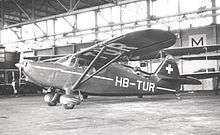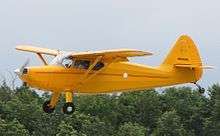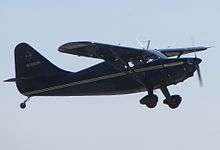Stinson 108
The Stinson 108 was a popular general aviation aircraft produced by the Stinson division of the American airplane company Consolidated Vultee, from immediately after World War II to 1950. It was developed from the prewar Model 10A Voyager.[2] Stinson was bought by Piper Aircraft in 1949. All Stinson model 108, 108-1, 108-2, 108-3 and 108-4 aircraft were built by Stinson at Wayne, Michigan. When Stinson sold the type certificate to Piper in 1949, approximately 325 airplanes of the 5,260 model 108s built by Stinson were complete but unsold. These 325 model 108s went to Piper as part of the sale. Piper then sold that inventory as the Piper-Stinson over the next few years.
| Stinson 108 | |
|---|---|
 | |
| A Canadian 1949 model Stinson 108-3 on skis. The partial span leading edge slot is visible | |
| Role | Private owner aircraft |
| National origin | United States |
| Manufacturer | Stinson Aircraft Company |
| First flight | December 1, 1944 |
| Produced | 1946-1950 |
| Number built | 5,260[1] |
| Developed from | Stinson Voyager |
Design and development
The fuselage was of fabric-covered steel tube. Aftermarket modifiers have obtained supplemental type certificates (STC) allowing conversion to an aluminum covering. Many different engines have been installed in the 108 by STC such as the Lycoming O-360, Franklin O-350, Continental O-470.[3]

One distinctive feature was the partial leading edge slot installed on the wings and aligned with the ailerons on the trailing edge, ensuring that the portion of the wing containing the aileron remains unstalled at higher angles of attack, thus contributing to docile stall behavior.
Total new production of the Stinson Model 108, by Stinson, was 5,260; this total does not include the two converted prototypes. Stinson delivered approximately 4,935 aircraft and Piper delivered approximately 325 aircraft.[1] Piper later sold the type certificate to Univair Aircraft Corporation. Univair built and certified the model 108-5, but built only one example. Total new model production by Stinson and Univair was 5,261 aircraft.
Variants

The 108 variants closely resemble each other but can be visually distinguished by their design changes:
- Prototype 108
- Two prototype model 108s were converted from Stinson model 10A airframes. FAA records show NX31519 was model 108 serial number 1, and NX31532 is model 108 serial number 2. Both registrations later changed to NC. The production model straight 108 would also use serial number 1 and 2, so there was for a short period 2 duplicate serial numbers;[4]
- 108 Voyager 125
- Powered by a 125 hp (93 kW) Lycoming O-235 piston engine.[5]
- 108 Voyager 150
- Powered by a 150 hp (112 kW) Franklin 6A4-150-B31, B3 or B4 piston engine.[5][6] 742 built in 1946.[6]
- 108-1
- Slightly modified version with external baggage door. 1508 built 1947–1948.[6]
- 108-2
- Powered by 165 hp (123 kW) Franklin 6A4-165-B3 or -B5. 1250 built from May 1948.[6] There was a conversion kit to add the rudder trim to the earlier airplanes advertised.

- 108-3
- The 108-3 introduced a taller vertical fin with a rudder featuring a straight trailing edge. Larger fuel tanks (50 U.S. gallons (190 L; 42 imp gal) versus 40 U.S. gallons (150 L; 33 imp gal)) were also fitted. The -3 has a higher gross weight than its predecessors of 2,400 lb (1,089 kg). 1760 built by Stinson and Piper.[7]
- 108-4
- The 108-4 was a higher powered model 108, sn 108-4693, NX149C, not certified, flown experimentally by Stinson, later by Piper, 1 built.[8]
- Flying Station Wagon
- The "Flying Station Wagon" version was an option available with the -1, -2 and -3 models, had a utility interior [2] incorporated wood paneling and a reinforced floor, allowing 600 lb (272 kg) of baggage in the passenger compartment. The aircraft could be fitted with wheel, float or ski landing gear. The single 108-4 built was a Flying Station Wagon.
- 108-5
- A single 108-5 was built by Univair, who purchased the Stinson 108 type certificate from Piper, in 1964. The 108-5 used a 180 hp (134 kW) Franklin 6A-335-B1 engine. Univair offered kits to convert earlier aircraft to this standard.[9][10] The 108-5 brought total model 108 production to 5,261, of which 5,135 were built by Stinson, 125 by Piper, and 1 by Univair.[9]
Specifications (108 Voyager 150)
Data from Plane and Pilot,[11] Jane's all the World's Aircraft 1947,[5] Stinson Operating Manual[12]
General characteristics
- Crew: one
- Capacity: three passengers
- Length: 24 ft 6 in (7.46 m)
- Wingspan: 33 ft 11 in (10.33 m)
- Height: 6 ft 10 in (2.08 m)
- Wing area: 155 sq ft (14.4 m2)
- Aspect ratio: 7.14
- Airfoil: NACA 4412
- Empty weight: 1,206 lb (547 kg)
- Gross weight: 2,150 lb (975 kg)
- Fuel capacity: 50 US gallons (190 l; 42 imp gal)
- Powerplant: 1 × Franklin 6A4 150-B3 six cylinder air-cooled horizontally opposed four stroke piston engine, 150 hp (110 kW)
- Propellers: 2-bladed Sensenich, 6 ft 4 in (1.93 m) diameter
Performance
- Cruise speed: 121 mph (195 km/h, 105 kn)
- Landing speed: 75 mph (65 kn; 121 km/h)
- Stall speed: 61 mph (98 km/h, 53 kn)
- Never exceed speed: 148 mph (238 km/h, 129 kn)
- Range: 500 mi (800 km, 430 nmi)
- Service ceiling: 14,000 ft (4,300 m)
- Rate of climb: 770 ft/min (3.9 m/s)
- Wing loading: 13.8 lb/sq ft (67 kg/m2)
- Power/mass: 14.33 lb/hp (8.69 kg/kW)
- Take-off run: 183 yd (167 m)
See also
Related development
Aircraft of comparable role, configuration and era
References
- Stinson Voyager Production Record
- Simpson, Rod (2005). The General Aviation Handbook. Midland Publishing. p. 290. ISBN 1-85780-222-5.
- . Western Aviation Magazine. 1962. p. 37. Missing or empty
|title=(help) - FAA Records for NX31519 and NX31532
- Bridgman, Leonard, ed. (1947). Jane's all the World's Aircraft 1947. London: Sampson Low, Marston & Co. pp. 293c–294c.
- Wegg 1990, p. 143
- Wegg 1990, pp. 143–144
- FAA Records for NX149C
- Wegg 1990, p. 144
- Taylor 1980, p. 448
- Plane and Pilot: 1978 Aircraft Directory, page74. Werner & Werner Corp, Santa Monica CA, 1977. ISBN 0-918312-00-0
- Stinson Operating Manual, 1946
- Taylor, John W. R., ed. (1980). Jane's All The World's Aircraft 1980-81. London: Jane's Publishing. ISBN 0-7106-7105-9.CS1 maint: ref=harv (link)
- Wegg, John (1990). General Dynamics Aircraft and their Predecessors. London: Putnam. ISBN 0-85177-833-X.CS1 maint: ref=harv (link)
Further reading
- Andrade, John (1979). U.S.Military Aircraft Designations and Serials since 1909. Midland Counties Publications. ISBN 0-904597-22-9.
External links
| Wikimedia Commons has media related to Stinson 108. |